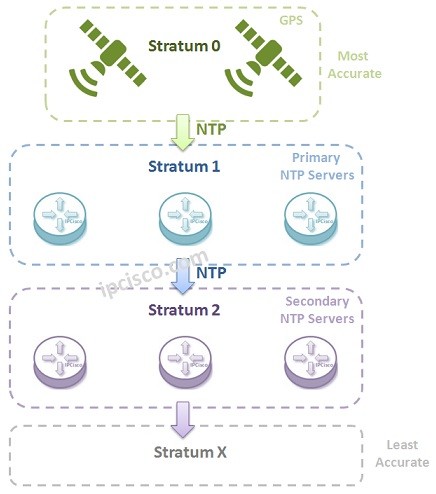- COURSES
- SPECIALS
- BLOG
- MEMBERS
- SHOP
- ABOUT
- ENROLL HERE

Table of Contents
The time on the network devices are very important. In a network all the devices’ times need to be synronized. Using the same time on all the devices in network is especially very important for troubleshooting activities. This time synronization is done by NTP (Network Time Protocol) and SNTP (Simple Network Time Protocol). Here, we will focus on Network Time Protocol, you will learn what is NTP, what is NTP port, roles, stratum levels and more. On another lessons, we will also learn How to Configure NTP on Cisco devices and PTP (Precision Time Protocol) and PTP Cisco Configuration.
Think about. You are analyzing a problem and you are waiting a certain packet at a time. But because of an unsyncronized time, you are missing the logs related with that problem or it is coming lately.
To overcome such issues, NTP (Network Time Protocol) is developed. With NTP, the times on various network devices in a network is synronized.
NTP (Network Time Protocol) uses UDP (User Datagram Protocol) as Transport Layer Protocol. In other words, NTP uses UDP 123 Port.
Network devices send their “timestamps”, eachother to synronize their clocks. You can see the same synronized clocks on all the device logs.
NTP time information can be get from any source. This source is called NTP Server. The other devices in the network are called NTP Clients. There is also another type device that act as NTP Client/Server.
What are these NTP devices’ roles? These roles are:
After learning what is NTP, in this part NTP Stratum Levels will be explained. Stratum Levels are shows the quality of the time source or NTP Server. The lover stratum values means that it is a better source. The higher ones means that it is not.
What are these Stratum Levels? These Stratum Levels are:

Stratum-0 is the directly attached source level. The time is received via dedicated transmitter or satellite with Stratum-0.
Stratum-1 is the source level that is linked to the directly attached device (Stratum-0).
Stratum-2 is the source level that is linked to the Stratum-1 device.
Stratum-3 is the source level that is linked to the Stratum-2 device.
Stratum-4 is the source level that is linked to the Stratum-3 device.
And so on…
In a network, there can be one more NTP Server configured with different Stratum values. According to these values, one of them become the best NTP Server. This is the one that has the lowest stratum level.
For example, think about that, we have three NTP Server with Stratum levels 3,4 and 5. In this network our NTP Server will be the device that is set with Stratum Level 3. If this device fails, then the second NTP Server will become the device that has Stratum Level 4.
Here, we have leared what is Network Time Protocol, Stratum Levels, Server and Client roles, NTP Port 123 and more. You can continue with Cisco NTP Configuration Example.
NTP (Network Time Protocol) and SNTP (Simple Network Time Protocol) are two network time syncronization protocols. What is the difference between NTP and SNTP? When we compare these two protocols, the key difference is about the way each one checks and corrects the network time.
NTP (Network Time Protocol) continually checks the time on network devices with the time provided by your server. On the other hand, SNTP (Simple Network Time Protocol) checks network time in the configured intervals. When you use SNTP, during this long intervals, network device can lost their correct time. So, for critical systems, Network Time Protocol is a better choice than Simple Network Time Protocol.
Leave a Reply